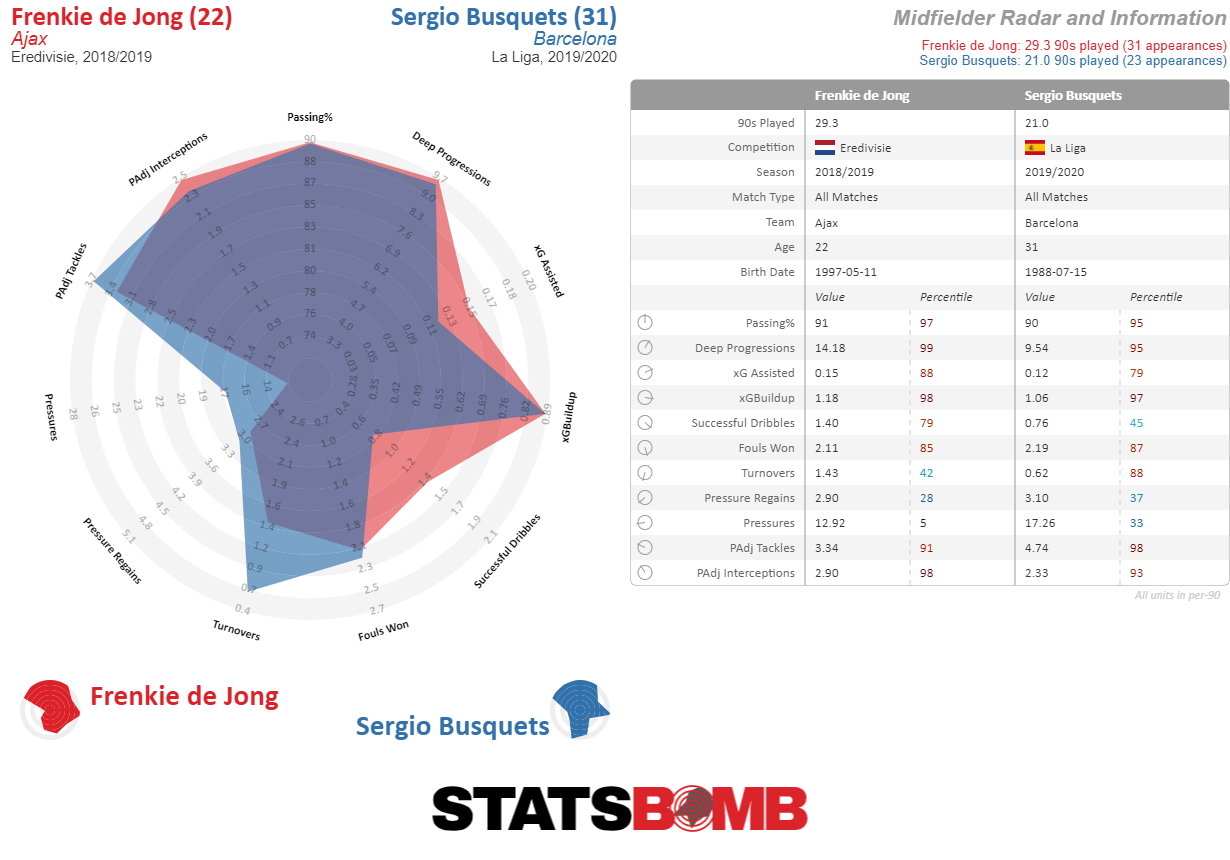We have reached the point in Barcelona's current crisis where everything and everyone involved in the club is being questioned. Blame is in unlimited supply and nobody is safe. The squad has lost faith in Setién according to one report. Eder Sarabia, Setién's assistant manager, is a loose cannon and needs to tone it down says another. Ter Stegen might want to leave according to a different report and Jordi Alba was forced to cover his ears against Real Sociedad to drown out the whistling fans. There are also discontented murmurs about Frenkie de Jong and his role in the team.
On a scale of 1 to 10 with 10 being Barcelona’s president being accused of hiring social media accounts used to disparage players, de Jong being played out of position is a two. But it’s important because de Jong was seen as a (almost) zero-risk signing.
De Jong was seen as a safe bet; the golden boy. He had charmed Barcelona fans with his beaming smile, golden hair, his assuredness both on and off the field and with a limitless future ahead of him. The 22-year-old doesn't say anything wrong because he hardly speaks. The only time he lifts his head is to seek a pass.
He was built in the home of Johan Cruyff and while it's not Barcelona DNA, it's a similar enough strand – a distant relative who you still look eerily similar to. Take the ball, pass the ball. It's what de Jong does best as we saw during Ajax's impossible run to the Champions League semi-final last year. We see it every time he pulls on the Oranje of Netherlands too when he seems to grow an inch in stature. That’s not how it is at Barcelona though as he seems to shrink into his role at the Camp Nou.
The risk was none and the expectations were high. That's possibly why the discontent has crept in because while he has performed well, he is still being played out of position. Barcelona have been searching for an Andres Iniesta replacement since he left for Japan. Andre Gomes was seen as a potential heir to the crease Iniesta had worn in the left of a midfield three at the Camp Nou but that turned out horribly for everyone before he left for Everton. Philippe Coutinho was drafted in as a more expensive and attacking solution but that went the same way.
Antoine Griezmann was touted as a player who might be able to play in the role too but has he played further forward and is entirely different to Iniesta anyway. Frenkie de Jong is being shoe-horned into the same role and has suffered in his first season because of that.
A look at Iniesta and de Jong comparisons show that the magician from Albacete was a far more accomplished attacker. Iniesta didn’t run but glide. He didn’t pass to team-mates, he caressed the ball into their path. He didn’t dribble, he skipped by defenders. Comparing de Jong's first season at Barcelona to Iniesta's last we can see that the young Dutchman is doing a reasonable, if clearly lesser imitation.
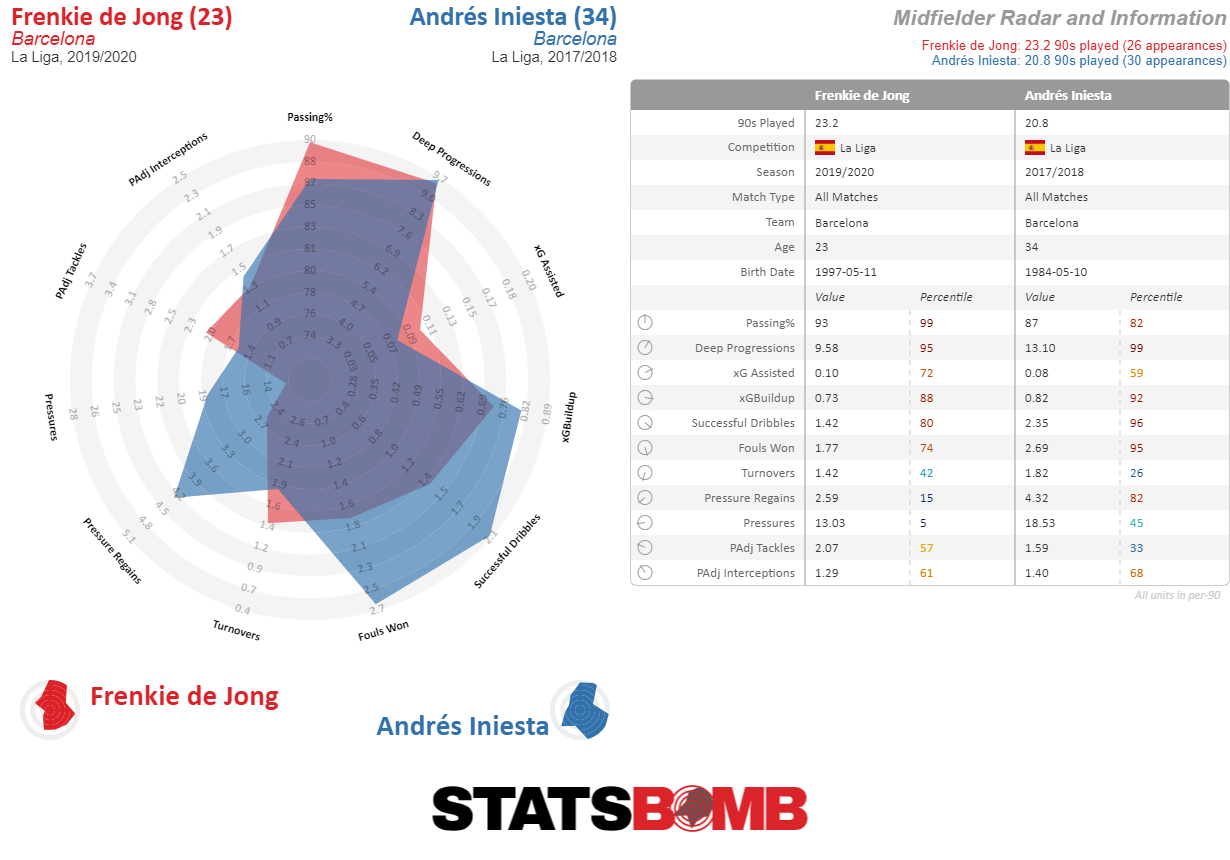
De Jong’s last year at Ajax was more similar to Sergio Busquets, which is where the problem arises. Here's his last season at Ajax and the current season for Barcelona's stalwart midfielder.
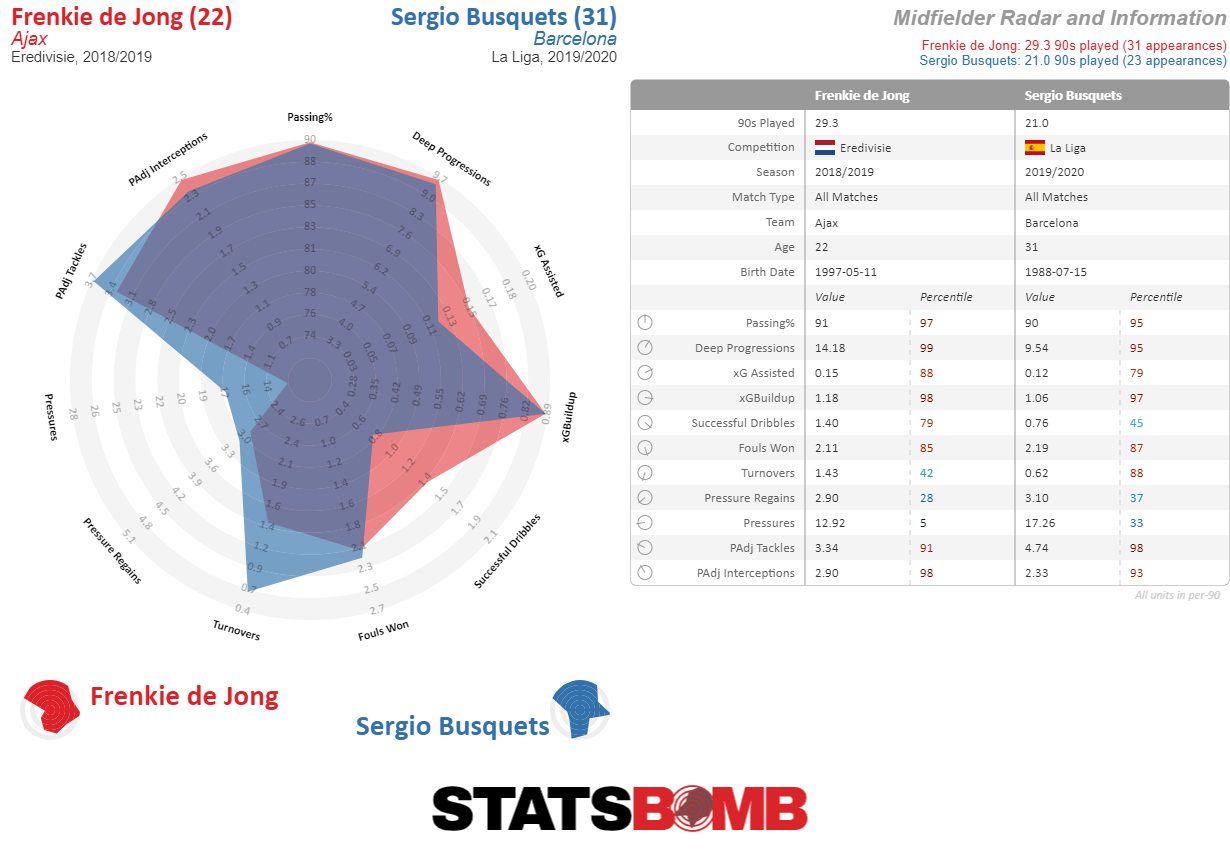
"The positive thing is that he plays a lot of games, but he's playing in a different position to what he's used to. He plays differently with me in the national team,” said Ronald Koeman as a man in a good position to know. Koeman is the coach of the Netherlands, gave de Jong his debut for his country and played for both Ajax and Barcelona during a glittering career. In every game under Koeman, he has played de Jong as the deepest midfielder in a double pivot. He is mostly positioned beside the more destructive Martin de Roon as a nice complement.
What is De Jong’s best position?
When De Jong was signed for Barcelona, Cruyff ultras rejoiced. He was set to be the pièce de résistance in Barcelona’s midfield for years to come. He was going to bring back the silky smooth passing of a bygone era and Barça could slowly ease Sergio Busquets out of the team knowing they had someone to replace him.
But that vision has not become reality.
He has played in left central midfielder and right central midfield more than he has played as a central defensive midfielder, his best position, and was even deployed as a left midfielder in a 4-4-2 against Real Madrid recently, looking suitably uncomfortable. Under Setién, De Jong is playing in left midfield in a 4-3-3. He is further ahead of Busquets with a carrousel of players coming and going in the right midfield position.
The belief seems to be that De Jong, who is so good as a progressive passer, will be more dangerous in a more attacking role – a counter-intuitive belief. He has been turned into a runner, a dribbler, a connector of midfield and attack when his best position is sitting deep, breaking up playing, starting attacks and receiving the ball from his goalkeeper and defenders. The term ‘salida de balón’ – bringing the ball out from the back, essentially – has saturated Setién’s tactics talk since he took over.
The concept is so important to him that there are times when it seems it is all he talks about. But he doesn’t have the best young player in the world at receiving the ball where he needs to be. And by having De Jong in a more attacking position and shunted to the left of midfield, he is also missing out on his best qualities as a defender.
De Jong’s Defensive input
"Of course he was the man of the match, it was well deserved," Koeman said after his performance against England in the Nations League final. "Most of the people are always looking at what he does with the ball, how calm he is, but look how well he defend and how many balls he is winning in midfield -- it's fantastic to see Frenkie play like this.”
Koeman, never shy with his opinion as is the Dutch modus operandi, was making an important point and something that has been lost since on his way to Barcelona. It’s something Barcelona are missing as Gerard Piqué and Clement Lenglet are often left fighting fires when teams attack them on the counter.
Two very interesting statistics when it comes to this is De Jong’s output for Barcelona compared to last year with Ajax. He had 63 tackles and 52 interceptions last season. He has obviously played six games less so far this season but unless he goes on a rampage in the next few games in LaLiga, he won’t catch up. He has just 19 interceptions this season with Barcelona and 30 tackles in 24 games. Adjusting for possession, and looking at the numbers on a per 90 basis, de Jong has gone from 3.34 possession adjust tackles per 90 and 2.90 possession adjusted interceptions to 2.07 and 1.09 at Barcelona respectively. That's a massive drop.
De Jong has come into a team that does a lot less pressing than what he was used to. His positioning when teams were forced to play rushed passes was impeccable as we can see with the numbers mentioned beforehand. Despite starting as the deepest midfielder, de Jong frequently stepped up the pitch at Ajax to break up play.
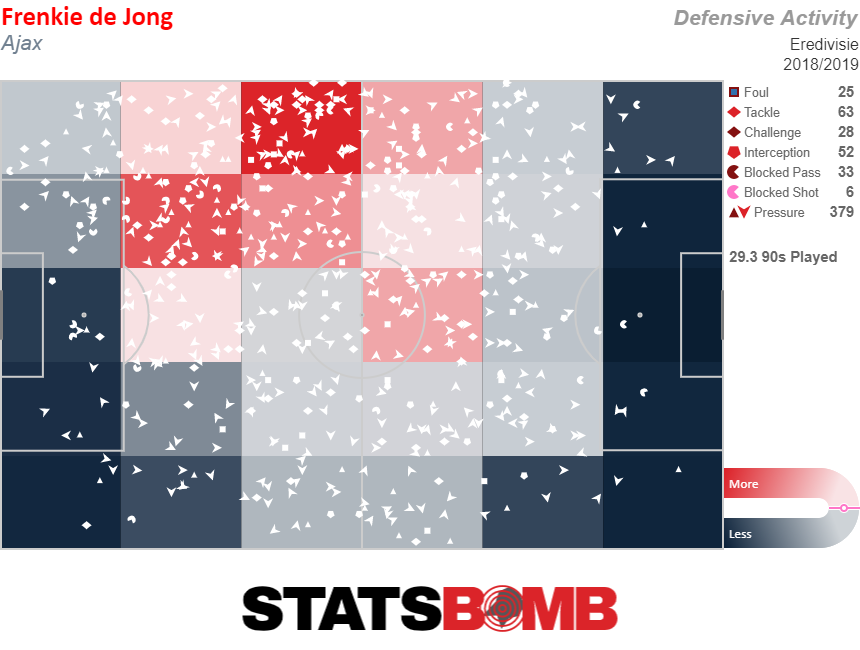
Now though, as we saw against Real Sociedad, he is being forced not to win the ball in transition but to try and win it against a team given time to build. De Jong is often left watching the ball pass him by as he chases opponents, while his ranginess goes to waste and he's left to patrol only the narrow areas in the channels where he's assigned.
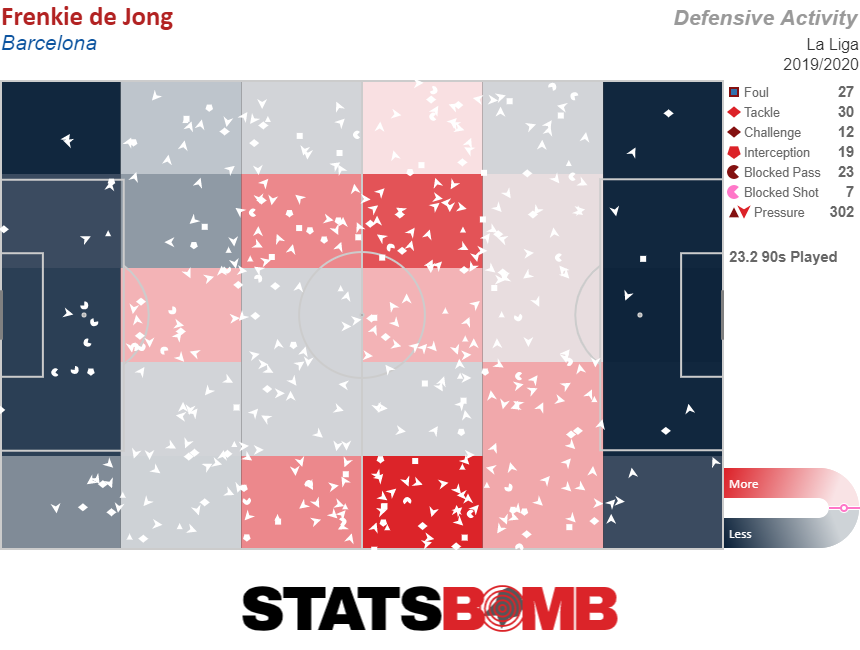
In summary, De Jong is playing well in a position he is not comfortable in. He is further forward than he is used to and doesn’t have the chance to affect the game defensively. He is still doing all the good things he did at Ajax, and has the second-most deep progressions in the team after Messi. It’s the same thing he does so well with the Netherlands but like Koeman says, he is not as involved in the defensive side of things.
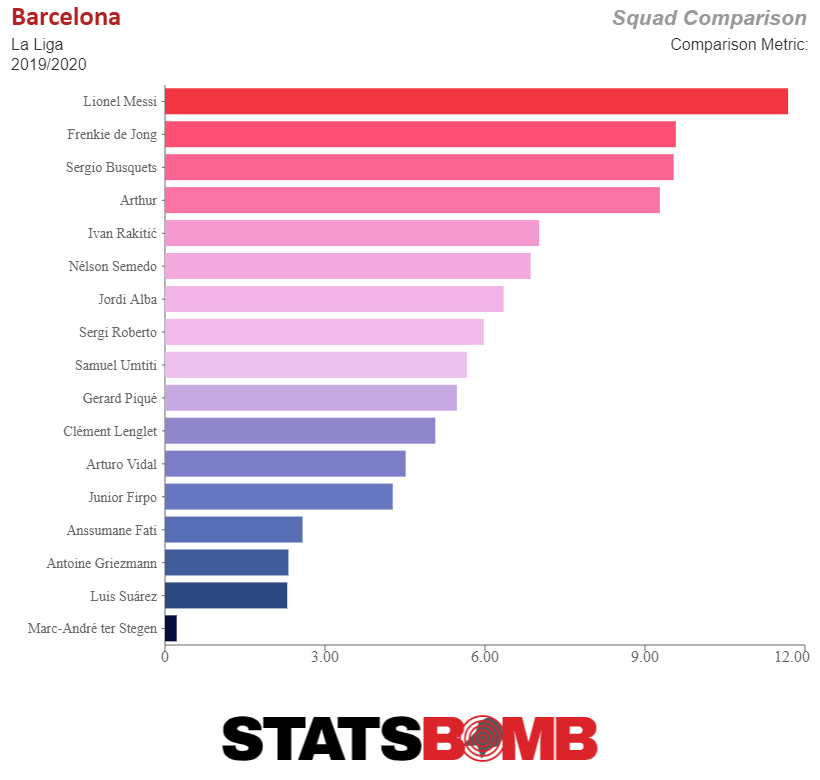
Aside from the fact that his interceptions and tackles are way down, it’s his overall involvement and how he feels in the team that is affected. We saw at the Bernabeu two weekends ago when he was running around chasing Fede Valverde and Dani Carvajal, which he did diligently, that he looked lost. The Dutchman found himself on the edge of the box ahead of the ball too many times when he is best arriving late and causing damage in his own time.
Busquets is not droppable yet because his performances haven’t merited it but it’s only a matter of time before the clamour to have De Jong deployed in his best position becomes too loud. As Barcelona trudge through this season, De Jong is a small concern but they might alleviate a lot of the symptoms of their current crisis on the field by giving him a more central role than the peripheral one he is currently occupying.
